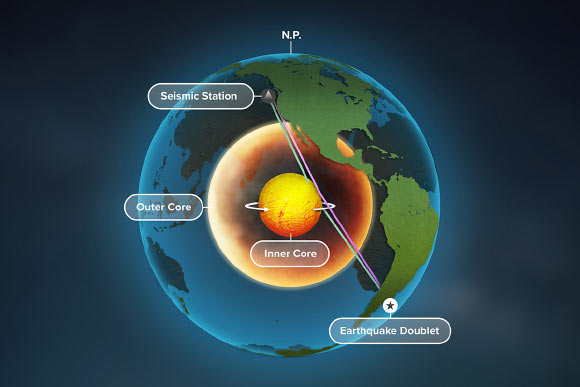The inner core of the Earth is rotating at about 0.05-0.1 degrees per year, according to an analysis of seismic data from repeating earthquakes published in the journal Earth and Planetary Science Letters.

Yang & Song found that refracted waves (blue), rather than reflected waves (purple) change over time, providing the best evidence yet that Earth’s inner core is rotating. Image credit: Michael Vincent.
Geoscientists do not fully understand how the Earth’s magnetic field generator works, but they suspect it’s closely linked to dynamic processes near the inner core-outer core boundary area.
Shifts in the location of the magnetic poles, changes in field strength and anomalous seismic data have prompted them to take a closer look.
“In 1996, a small but systematic change of seismic waves passing through the inner core was first detected by our group, which we interpreted as evidence for differential rotation of the inner core relative to the Earth’s surface,” said senior author Professor Xiaodong Song, a researcher at the University of Illinois at Urbana-Champaign and Peking University.
“However, some studies believe that what we interpret as movement is instead the result of seismic waves reflecting off an alternately enlarging and shrinking inner core boundary, like growing mountains and cutting canyons.”
Professor Song and Yi Yang, a graduate student at the University of Illinois at Urbana-Champaign, analyzed seismic data from a range of geographic locations and repeating earthquakes, called doublets, that occur in the same spot over time.
“Having data from the same location but different times allows us to differentiate between seismic signals that change due to localized variation in relief from those that change due to movement and rotation,” Yang explained.
The scientists found that some of the earthquake-generated seismic waves penetrate through the iron body below the inner core boundary and change over time, which would not happen if the inner core were stationary.
“Importantly, we are seeing that these refracted waves change before the reflected waves bounce off the inner core boundary, implying that the changes are coming from inside the inner core,” Professor Song said.
The basis of the debate lies in the fact the prior studies looked at a relatively small pool of somewhat ambiguous data generated from a method that is highly dependent on accurate clock time.
“What makes our analysis different is our precise method for determining exactly when the changes in seismic signals occur and arrive at the various seismic stations across the globe,” Yang noted.
“We use a seismic wave that did not reach inner core as a reference wave in our calculations, which eliminates a lot of the ambiguity.”
“This work confirms that the temporal changes come mostly, if not all, from the body of the inner core, and the idea that inner core surface changes are the sole source of the signal changes can now be ruled out,” Professor Song said.
_____
Yi Yang & Xiaodong Song. 2020. Origin of temporal changes of inner-core seismic waves. Earth and Planetary Science Letters 541: 116267; doi: 10.1016/j.epsl.2020.116267







